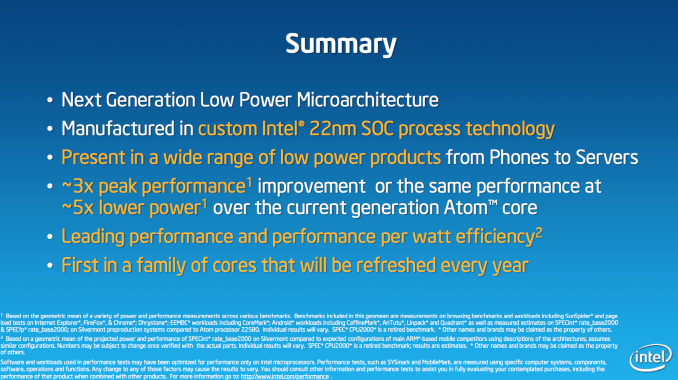Intel’s Silvermont Architecture Revealed: Getting Serious About Mobile
by Anand Lal Shimpi on May 6, 2013 1:00 PM EST- Posted in
- CPUs
- Intel
- Silvermont
- SoCs
Final Words
Silvermont really is Intel’s Conroe for the mobile market, but not in the sense that many have been expecting. Given that success in mobile is so closely tied to device wins, Silvermont alone isn’t enough. Unlike Conroe, a very competitive Silvermont won’t change the world overnight. What Silvermont does however is offer a great foundation for Intel going forward. Conroe lead to Penryn, Nehalem, Westmere, Sandy Bridge, Ivy Bridge and soon, Haswell. It was the platform that Intel could build on regularly by executing on tick-tock. Conroe paved the way for the insane advantage Intel has held onto for the past few years. Silvermont is like Conroe in that it provides that same foundation.
The mobile market is far more competitive than the PC industry was back when Conroe hit. There isn’t just one AMD but many competitors in the SoC space that are already very lean and fast moving. There’s also the fact that Intel doesn’t have tremendous marketshare in ultra mobile. Silvermont may feel a lot like Conroe, but the market it’s competing in is very different. That’s not to say that Intel can’t be successful here; it’s just not going to be easy.
Architecturally Silvermont is very conservative, and that’s not a bad thing. A side effect of not wanting to make Haswell irrelevant by a far lower cost part is the benefit of maintaining power efficiency. Intel joins the ranks of Apple and Qualcomm in intelligently scaling performance while respecting power consumption. Intel’s 22nm process should give Silvermont a lot of runway to use. If it can quickly follow up with 14nm, Silvermont’s power advantage could end up being akin to Conroe’s performance advantage in the mid-2000s.
Even so, Silvermont is long overdue. It’s the first mobile architecture where Intel really prioritized smartphones and tablets, and on paper, it looks very good. Now it’s up to Intel to turn a great architecture into great design wins. From what I’m hearing, we may actually see that happen.











174 Comments
View All Comments
PolarisOrbit - Monday, May 6, 2013 - link
Re: FSBIntel tried to get rid of the FSB several years ago, but it was seen as anti-competitive because they simultaneously locked out 3rd parties like Nvidia Ion. One lawsuit later, Intel was bound to keep the FSB in their low power architectures until 2013 for 3rd party support. Basically Intel wasn't playing fair and Nvidia burned their ship.
DanNeely - Tuesday, May 7, 2013 - link
There was no usable FSB in anything beyond the first series of atom chips. The rest still had it within the die to connect the CPU with the internal northbridge; but the only external interface it offered was 4 PCIe2(?) lanes. ION2 connected to them; not to FSB.Kevin G - Tuesday, May 7, 2013 - link
Actually Intel is to keep PCI-e on their chips until 2016 by that anti-trust suit. This allows 3rd part IP, like nVidia's ION, to work with Intel's SoC designs.tipoo - Monday, May 6, 2013 - link
This makes me wonder if companies that make in-house SoCs (I guess Apple in specific, since Samsung also sells them to others while Apple just does it for themselves) will ever switch mobile devices to Intel if they just can't match the performance per watt of this and future Atom cores.tipoo - Monday, May 6, 2013 - link
Also won't the much anticipated SGX 600 series/Rogue be out by around then? That's the GPU that's supposed to take these mobile SoCs to the 200Gflop territory which the 360/PS3 GPUs are around.xTRICKYxx - Tuesday, May 7, 2013 - link
I would think Apple would (or any company) would want all of their software running on the same architecture/platform if they could.R0H1T - Tuesday, May 7, 2013 - link
And kill what a billion or so iDevices sold with incompatibility ? Me thinks you dunno what you're talking about !CajunArson - Monday, May 6, 2013 - link
Did somebody pay you to post that reply? Because if so, they aren't getting their money's worth.Silvermont Atoms are targeted at smartphones in 2-core configurations and tablets in the 4-core Baytrail configurations. Their power consumption is in a completely different league than even the low-end Temash parts. Let me reiterate: a Temash with a 4 watt TDP is going to have substantially higher real-world power consumption than even a beefy Baytrail and will likely only compete with the microserver Atom parts where Intel intentionally targets a higher power envelope.
I'm sure you can't wait to post benchmarks of a Kabini netbook with a higher power draw than Haswell managing to beat a smartphone Atom as proof that AMD has "won" something, but for those of us on planet earth, these Silvermont parts are very interesting and we appreciate hard technical information on the architecture.
nunomoreira10 - Tuesday, May 7, 2013 - link
Jaguar will be available on fanless designs wille haswell wont, you cant realy compare them.The facto is intel still doesn't hás a good enougf CPU for a good experiency on a legacy windows 8 fanless design, there is this big hole in the market that AMD is trying to seek.
raghu78 - Monday, May 6, 2013 - link
Intel silvermont is the start of the Intelization of the mobile world. within the next 2 - 3 years Intel should have bagged Apple , Google or Samsung. with the world's best manufacturing process which is atleast 2 - 3 years ahead of other foundries and Intel's relentless tick - tock chip development cadence the ARM crowd is going to be beaten to a pulp. Qualcomm might survive the Intel juggernaut but Nvidia will not.